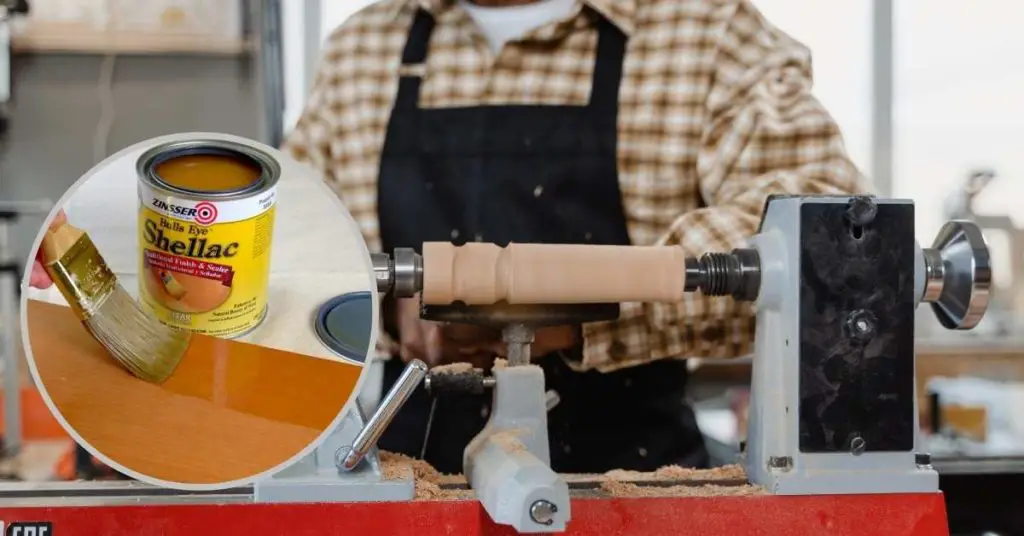Can You Really Apply Shellac on a Lathe?
Shellac has a long history of use in woodworking. It was originally used as a finish for French polishing.
The answer is yes, and you can apply shellac on a lathe. Shellac can be applied to a lathe in a few different ways.
The most common way is to apply it with a rag. Applying shellac to a lathe is not difficult, but there are a few things you need to know before you start.
What is Shellac?
Shellac is a natural resin secreted by the female lac bug. It is obtained from trees in the forests of India and Thailand.
The resin is harvested and then processed to create a material that can be used in a variety of applications, including as a wood finish, electrical insulation, and a protective coating for metal surfaces.
Shellac has been used as a wood finish for centuries, and its popularity has grown in recent years as more people have become interested in using natural products in their homes.
Shellac is easy to apply and provides a beautiful, durable finish that enhances the natural grain of the wood.
It is also water resistant, making it an ideal choice for protecting outdoor furniture or any other wood surface that may be exposed to moisture.
Shellac is also an excellent electrical insulator and is often used to coat the wires and other components of electrical devices. This helps to prevent shorts and other problems that can occur when the electricity comes into contact with metal surfaces.
Shellac can also be used as a protective coating for metal surfaces.
It is especially effective in protecting against corrosion and tarnishing, making it a good choice for use on jewellery or other items that may come into contact with water or other liquids.
Shellac is a versatile material that has a variety of uses. It is a natural product that is safe for use in the home, and it provides a durable, beautiful finish that enhances the appearance of wood surfaces.
If you are looking for an environmentally friendly option for finishing or protecting your wood surfaces, shellac is an excellent choice.
How to Apply Shellac While Turning on a Lathe?
If you’re looking to get a high-quality finish on your turned projects, shellac is the way to go.
Shellac produces a smooth, durable finish that can be buffed to a high shine. It’s also easy to repair if it gets damaged.
Applying shellac while turning on a lathe is a bit different than applying it to flat surfaces. The first thing you need to do is make sure that your workpiece is perfectly round. Any unevenness will show up in the finish.
Next, you need to apply the shellac with a brush or rag. Work from the centre of the workpiece towards the edge. Be sure to brush in the direction of the grain so that the finish is smooth.
Once the shellac is applied, you need to let it dry completely before buffing it out. If you try to buff it too soon, you’ll end up smearing the finish.
Shellac is a great option for getting a high-quality finish on your turned projects. Just be sure to follow these steps, and you’ll be sure to get a great result.
Visual Explanations: https://youtu.be/LN3XO91iRuM
What Tools Can be Used For Polishing While Turning on a Lathe?
There are a few different ways that you can go about polishing your workpiece while you are using a lathe. You can use a piece of sponge, microfiber or cotton.
It’s important not to use rough materials as this can damage the surface of your workpiece.
Sponge:
You can use a sponge to apply polishing compounds to your workpiece. Simply wet the sponge and then dip it into the polishing compound. Apply the compound to the workpiece in a circular motion.
Microfiber Cloth:
A microfiber cloth can be used in a similar way to a sponge. Wet the cloth and then dip it into the polishing compound. Apply the compound to the workpiece in a circular motion.
Cotton Cloth:
Cotton can be used to apply polishing compounds to your workpiece in a similar way to a sponge or microfiber cloth. Wet the cotton and then dip it into the polishing compound.
When polishing with a lathe, it is important to use a consistent speed and pressure. Too much pressure can create heat, which can damage the workpiece. It is also important to keep the lathe clean and free of debris.
How to Make a High-Gloss Finish While Turning on a Lathe?
One of the most impressive things you can do while woodturning is to create a high-gloss, perfectly smooth finish on your projects.
This level of finish is usually only found on store-bought furniture or professional turned pieces, but with a little practice, it’s something that any woodturner can achieve.
You’ll need to start with a very smooth surface to get a high-gloss finish. The best way to do this is to sand your project down to at least 600 grit sandpaper.
If you’re working with particularly soft wood, you may even want to go up to 1,000 grit.
You’ll need to apply a finish once your surface is nice and smooth. A few different finishes can be used to achieve a high gloss, but we recommend using either shellac or lacquer.
Once you’ve applied your finish, it’s time to start turning. The goal here is to apply enough pressure to the piece so that the finish starts to level out and become smooth.
You don’t want to put too much pressure on, as this can cause the finish to start to run or drip. Just apply enough pressure that the finish starts to even out.
Finally, once you’re happy with the level of glossiness, you can remove the piece from the lathe and allow it to dry completely.
And that’s it! With a little practice, you’ll be able to create a beautiful high-gloss finish on any of your woodturning projects.
Visual Explanations: https://www.youtube.com/watch?v=GAwjxRX45-U
What Are The Types of Finishes Other Than Shellac?
Different types of finishes can be used on woodworking projects, each with its own advantages and disadvantages. Some factors to consider when choosing a finish include durability, resistance to staining, ease of application, and drying time.
Other common finishes besides shellac include lacquer, varnish, polyurethane, oil-based paints, and water-based paints.
Lacquer is a durable finish that dries quickly, making it ideal for projects that will see a lot of wear and tear. It can be difficult to apply evenly, and brush strokes may be visible after the finish dries.
Varnish is another durable option that dries quickly but can yellow over time. It is also available in a water-based version that is less likely to yellow.
Polyurethane is a durable finish that is available in both oil- and water-based versions. It dries slowly, however, so it is not ideal for projects that need to be completed quickly.
Oil-based paints are durable and easy to apply, but they can take a long time to dry. Water-based paints are less durable but dry more quickly.
When choosing a finish for your project, consider the type of wood you are using, the intended use for the finished piece, and your personal preferences.
Some finishes will work better than others, depending on the specific circumstances. Experiment with different finishes until you find one that you are happy with.
How Does Shellac Differ From Other Polishing Chemicals?
Shellac is a natural product that has been used for centuries as a wood finish and polish. It is made from the secretion of the lac bug, which is found in Asia.
The resin is harvested from the tree and then dissolved in alcohol to create a liquid finish.
Shellac has many benefits over synthetic polishes. It dries quickly, resists scratches and stains, and gives the wood a warm, natural glow. Shellac is also easy to apply and can be buffed to a high shine.
However, shellac does have some drawbacks. It is not as durable as synthetic finishes and can yellow over time.
Shellac is also susceptible to heat damage, so it should not be used on surfaces that will be exposed to direct sunlight.
If you are looking for a durable, long-lasting finish, shellac is not the best option. Also, if you want a natural product that will give your wood a warm glow, shellac is a good choice.
Related Matters
What is friction polish?
Friction polish is a finishing technique used to create a smooth, glossy surface on wood or other materials.
The process involves rubbing the material with a hard object, such as a piece of paper towel, to create friction and heat. This frictional force polishes the surface of the material and gives it a lustrous sheen.
Why do you use a wood sealer for?
There are a few reasons why you might use a wood sealer. One reason is to protect the wood from moisture damage. Sealing the wood will help to keep it from warping, rotting, or splitting.
Additionally, a sealer can also help to prevent staining and fading. Lastly, using a sealer can give the wood a nice glossy finish.
Should I sand the wood before waxing?
Yes, sanding the wood before waxing will help to ensure a smooth, consistent finish. The finish could be uneven and patchy if the wood is not sanded before waxing.
Sanding also helps to remove any dirt or debris from the surface of the wood, which can interfere with the adhesion of the wax.




